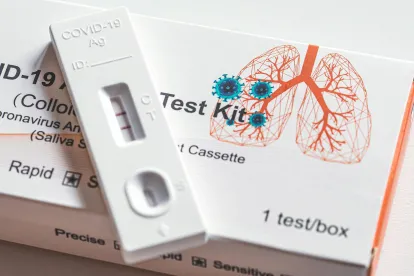I. Biden Administration Requirement for Insurance Companies to Cover Cost of At-Home COVID-19 Tests
On January 10, 2022, the U.S. Department of Health and Human Safety (HHS) announced that the Biden-Harris administration will be requiring insurance companies and group health plans to cover the cost of over-the-counter, at-home COVID-19 tests, so people with private health coverage can get them for free starting January 15, 2022. This new coverage requirement means that most consumers with private health insurance will be able to purchase an at-home COVID-19 test (online or at a pharmacy) and it will either be paid for directly by their health plan or the consumer can submit a claim for reimbursement.
Starting January 15, 2022, insurance companies and health plans will be required to cover eight (8) free over-the-counter at-home tests per covered individual per month, and there will be no limit on the number of tests that are covered if they are ordered or administered by a health care provider following an individualized clinical assessment.
As part of the new requirement, the administration is incentivizing insurers and group health plans to create programs that allow people to get the over-the-counter tests directly through preferred pharmacies, retailers, or other entities with no out-of-pocket costs. Retailers and other entities providing access to consumers for over-the-counter testing should be aware of the requirements. Even if plans and insurers make tests available through preferred pharmacies or retailers, such plans and insurers are still required to reimburse tests purchased by consumers outside of that network, at a rate of up to $12 per individual test (or, if less, the cost of the test)
II. Deviations Among Insurance Companies’ Updated Coverage Requirements
Insurance companies are adjusting their coverage policies in response to these new coverage requirements. being implemented by the Biden Administration. For example, Blue Cross and Blue Shield of California released guidance advising consumers that it will cover most COVID-19 diagnostic and screening tests at no out-of-pocket cost starting January 1, 2022. This includes tests for: symptomatic or asymptomatic testing; testing for contact-tracing; screenings ordered by healthcare providers; screenings for employment or return to work/school (which was not previously covered); and screenings before or after travel. This updated coverage will last as long as the mandates remain in place.
Other insurers, however, are keeping their prior requirements that only diagnostic tests individually ordered to diagnose or help in the treatment of individuals will be covered. As has been the case through the pandemic, some health plans do not cover COVID-19 surveillance testing, which is testing used for public health or social purposes such as employment (return to workplace), education, travel, or entertainment. These companies only pay for a COVID-19 test if it is FDA-authorized or approved and is ordered or reviewed by a health care professional to either diagnose if the virus is present in a person due to symptoms or potential exposure, or help in the treatment of the virus.
III. Increased Need For Attention On Billing Practices
Laboratory billing for COVID-19 testing generates significant revenue. The Office of the Inspector General reviewed the amount of spending on COVID-19 tests under Medicare Part B and found that $1.5 billion was spent on COVID-19 tests in 2020.[1] Such spending always draws reviews by payors as to the medical necessity and appropriateness of billing. With the advent of the new COVID-19 at-home testing coverage requirements as well as the varying coverage policies implemented by insurance companies, health care entities should be diligent in determining the appropriate billing requirements so as to ensure compliance.
[1] U.S. Department of Health and Human Services, Office of Inspector General, Data Brief, COVID-19 Tests Drove an Increase in Total Medicare Part B Spending on Lab Tests in 2020, While Use of Non-COVID-19 Tests Decreased Significantly (December 2021), available at https://oig.hhs.gov/oei/reports/OEI-09-21-00240.pdf
*This post was co-authored by Erin Howard, legal intern at Robinson+Cole. Erin is not yet admitted to practice law.



 />i
/>i

